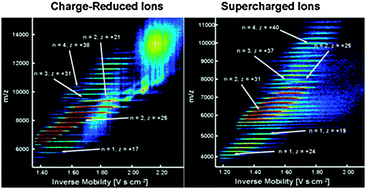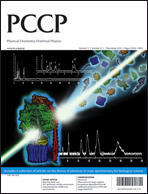We investigate whether “supercharging” reagents able to shift the charge state distributions (CSDs) of electrosprayed protein ions upward also influence gas-phase protein structure. A differential mobility analyzer and a mass spectrometer are combined in series (DMA-MS) to measure the mass and mobility of monomer and multimeric phosphorylase B ions (monomer molecular weight ∼97 kDa) in atmospheric pressure air. Proteins are electrosprayed from charge-reducing triethylammonium formate in water (pH = 6.8) with and without the addition of the supercharging reagent tetramethylene sulfone (sulfolane). Because the DMA measures ion mobility prior to collisional heating or declustering, it probes the structure of supercharged protein ions immediately following solvent (water) evaporation. As in prior studies, the addition of sulfolane is found to drastically increase both the mean and maximum charge state of phosphorylase B ions. Ions from all protein n-mers were found to yield mobilities that, for a given charge state, were ∼6–10% higher in the absence of sulfolane. We find that the mobility decrease which arises with sulfolane is substantially smaller than that typically observed for folded-to-unfolded transitions in protein ions (where a ∼60% decrease in mobility is typical), suggesting that supercharging reagents do not cause structural protein modifications in solution as large as noted recently by Williams and colleagues [E. R. Williams et al., J. Am. Soc. Mass Spectrom., 2010, 21, 1762–1774]. In fact, the measurements described here indicate that the modest mobility decrease observed can be partly attributed to sulfolane trapping within the protein ions during DMA measurements, and probably also in solution. As the most abundant peaks in measured mass-mobility spectra for ions produced with and without sulfolane correspond to non-covalently bound phosphorylase B dimers, we find that in spite of a change in mobility/cross section, sulfolane addition does not substantially alter the structure of non-covalently bound protein complexes in the gas-phase.

You have access to this article
 Please wait while we load your content...
Something went wrong. Try again?
Please wait while we load your content...
Something went wrong. Try again?


 Please wait while we load your content...
Please wait while we load your content...